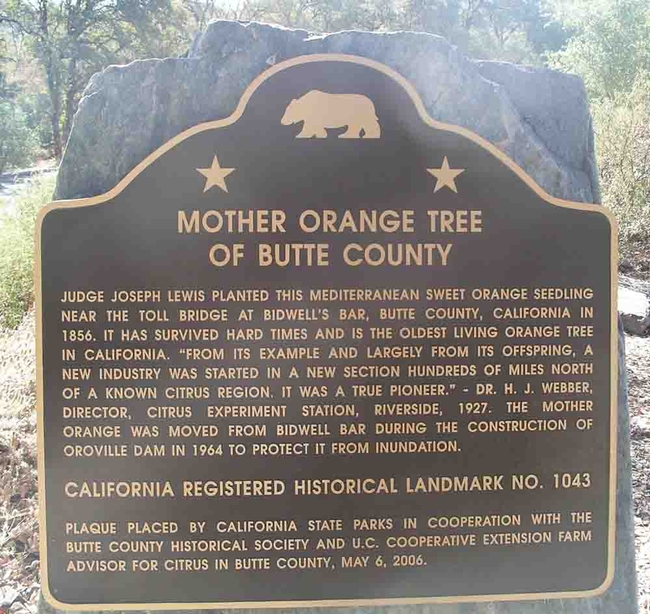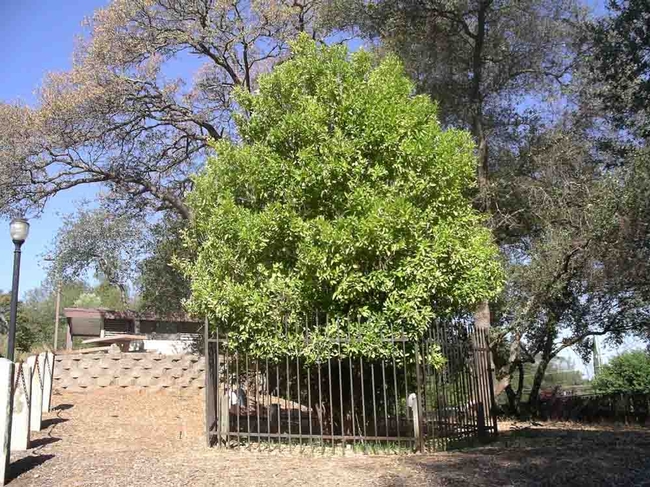Although California has a long history of the commercial growing of oranges and other citrus, citrus trees are not native to California. Citrus is native to South and East Asia, Melanesia and Australia. Sweet oranges were introduced to the Mediterranean from Asia by Genoese and Portuguese traders in the 15th-16th centuries. Franciscan missionaries brought sweet oranges to California around 1769. The first citrus orchard was planted in 1804 at the San Gabriel Mission, east of Los Angeles. The first commercial orange orchard was planted in 1841 near what is now downtown Los Angeles.

What is likely the oldest living orange tree in California, however, is growing right here in Butte County. The Mother Orange tree originated in Mazatlan, Mexico. It was planted in 1856 near the tollhouse for the Bidwell Bar suspension bridge, which spanned the middle fork of the Feather River, after Judge Joseph Lewis bought the 2-to 3-year-old seedling in Sacramento. The tree has been transplanted twice. In 1862 it was moved to the other end of the bridge due to the threat of flooding. In 1964 it was moved to 800 Glen Drive in Oroville during the construction of Oroville Dam. According to one of the plaques by the tree, “Early-day miners traveled from far and wide to eat her sweet oranges, gather the seeds, and plant them in the yards of their homes.”
Retired UC Cooperative Extension Farm Advisor Joseph Connell writes, “Following the success of the Mother Orange, by 1863 75 acres of orange trees had been planted in the county.” Orange production in Butte County peaked around 1900, when 3300 acres were devoted to orange cultivation; by 2007, orange acreage had declined to 162 acres (History of Butte County's Citrus Industry and the Mother Orange Tree).

The Mother Orange was damaged by severe freezes in 1990 and 1998. It stopped producing oranges, and its survival was in doubt. With additional care by Connell and the California Department of Parks and Recreation, the Mother Orange has recovered from the freeze damage and is again producing fruit. Extra efforts, including heat lamps and water misters, are employed to protect the tree from any more damage.
In an effort to maintain the existence of its genome, four new trees using budwood collected in 2001 from the Mother Orange were propagated at the University of California, Riverside (UCR) Citrus Clonal Protection Project (CCPP). Budwood is a short, leafless twig with buds used for grafting on another plant in order to propagate vegetatively. Two of the trees were planted in the UCR Citrus Variety Collection. The third and fourth were planted in Oroville, one in the orange grove next to the Lott home in Sank Park and the other next to the Butte County Historical Society Museum. A fifth tree locally propagated at the same time was planted at the Patrick Ranch Museum south of Chico.
The CCPP began at UCR in 1956. The first such project in the world, its purpose is to provide a safe mechanism for improving citrus varieties, introducing new varieties for research, and for propagating citrus for commercial or personal use. By law, every newly propagated citrus tree in the state can be traced back to a mother tree created through the program. This requirement ensures that all new citrus plants are disease-free. Incoming trees are tested for more than 30 citrus diseases. Any diseases identified in the first round of testing are eliminated by heat treatment of infected buds or shoot tip micrografting using small pieces of growing tips for new propagation. All propagations produced during the treatments are again tested for citrus diseases. Once a new tree passes the screening tests, it receives a variety index or VI number necessary for release to the public. The most recent variety index number, VI 1000, was awarded in June 2022 to a tree propagated at UCR with budwood from a clone of the Mother Orange tree. Dubbed the “Bidwell's Bar” variety, its budwood will now be available for purchase by commercial nurseries and citrus enthusiasts. Information about buying budwood from Bidwell's Bar or other citrus varieties is available at the CCPP website.
UC Master Gardeners of Butte County are part of the University of California Cooperative Extension (UCCE) system. To learn more about us and our upcoming events, and for help with gardening in our area, visit our website. If you have a gardening question or problem, email the Hotline at mgbutte@ucanr.edu or leave a phone message on our Hotline at (530) 538-7201. To speak to a Master Gardener about a gardening issue, or to drop by the MG office during Hotline hours, see the most current information on our Ask Us Hotline webpage.